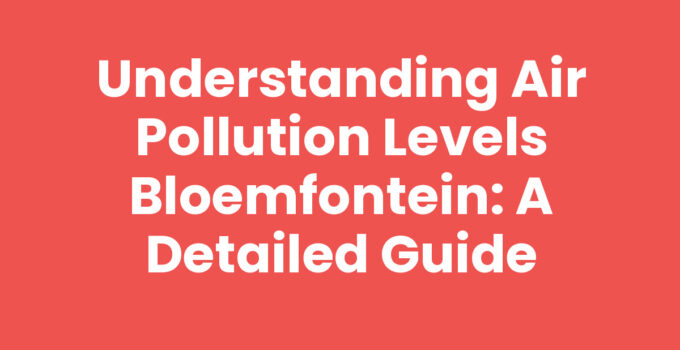Air quality has become a pressing issue across the globe, and South Africa is no exception. In Bloemfontein, residents often find themselves questioning the safety of the air they breathe, especially during winter months when pollution levels can skyrocket. This blog post aims to explore the air pollution levels in Bloemfontein, how they are measured, their impacts, and what steps can be taken to mitigate their effects.
Air Pollution Levels Bloemfontein: Understanding the Data and Sources
To truly grasp the state of air pollution in Bloemfontein, it’s essential to familiarize ourselves with the common pollutants and how their levels are determined. The most measured pollutants include:
- Particulate Matter (PM10 and PM2.5): These tiny particles can penetrate deep into the lungs and even enter the bloodstream.
- Nitrogen Dioxide (NO2): Often produced from vehicle exhausts and industrial processes, high levels of NO2 can cause respiratory diseases.
- Sulfur Dioxide (SO2): This gas comes primarily from industrial activities and has significant health implications.
- Ozone (O3): Ground-level ozone is formed when pollutants undergo chemical reactions in the presence of sunlight.
Monitoring Air Quality: The South African Weather Service (SAWS) and other organizations regularly monitor air quality by using air quality monitoring stations placed around the city. These stations provide real-time data, which is crucial for informing residents about pollution levels. Data can be accessed through their websites or mobile applications, allowing individuals to check pollution levels at various times of the day.
Recommended Guide: Exciting Outdoor Activities for Kids in Bloemfontein
The Health Risks of Air Pollution
It’s important to understand how elevated air pollution levels can impact health:
- Respiratory Conditions: Long-term exposure to polluted air increases the risk of chronic respiratory diseases such as asthma and bronchitis.
- Cardiovascular Diseases: Air pollution has been linked to heart attacks and other cardiovascular issues due to the stress it places on the heart.
- Impaired Lung Development: Children are particularly vulnerable, as exposure to polluted air can hinder lung development and lead to lifelong health issues.
- Premature Mortality: Numerous studies link high levels of air pollution with increased rates of premature deaths across various demographics.
Check This: Explore Airport Lounges at Bram Fischer, Bloemfontein Today
How to Reduce Exposure to Air Pollution in Bloemfontein
Staying informed is the first step to reducing exposure to air pollution. Here are several steps residents can take:
- Stay Indoors During High Pollution Days: When pollution levels are high, consider staying indoors, especially during peak traffic hours. Keep windows and doors closed to prevent outdoor air from entering.
- Use Air Purifiers: Investing in a high-quality air purifier can help reduce indoor air pollutants significantly, enhancing air quality inside your home.
- Limit Outdoor Activities: If you exercise outdoors, consider doing so during times when air pollution levels are lower, typically early in the morning or late in the evening.
- Advocate for Change: Participate in local environmental campaigns or advocate for more stringent air quality regulations from local government.
Conclusion
Air pollution levels in Bloemfontein are a crucial concern for residents, with real implications for health and well-being. By understanding the sources and impacts of pollution and implementing strategies to mitigate exposure, we can collectively work towards a healthier environment. Stay informed, stay safe, and don’t hesitate to advocate for cleaner air.
Recommended Reading: Fast and Reliable Same-day Delivery Bloemfontein Services
Frequently Asked Questions
What are the main sources of air pollution in Bloemfontein?
The main sources include vehicle emissions, industrial activities, and seasonal agricultural burning.
How can I check the current air quality in Bloemfontein?
You can check current air quality levels using the South African Weather Service's website or their mobile application.
What are the health risks associated with poor air quality?
Poor air quality can lead to respiratory diseases, cardiovascular conditions, and can aggravate existing health issues, especially in vulnerable populations.



